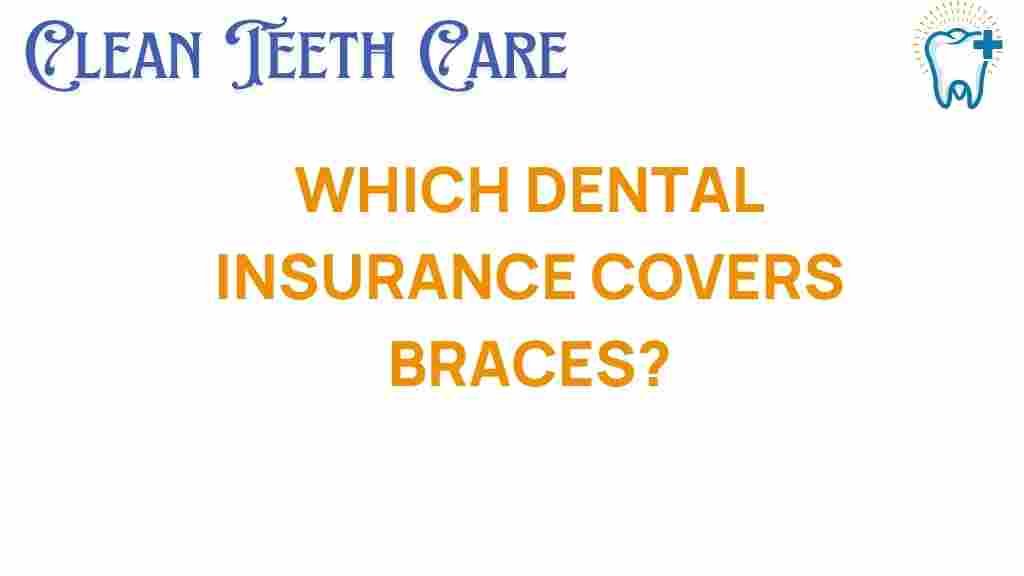Unlocking the Secrets: Which Dental Insurance Covers Braces?
For many individuals and families, achieving a beautiful smile often involves orthodontic treatment, specifically braces. However, the cost of braces can be a significant barrier. Fortunately, understanding how dental insurance works and which plans offer braces coverage can help ease the financial burden. In this article, we will explore the various insurance plans that cover braces, the types of orthodontics available, and how to navigate the complexities of financial assistance for your dental care needs.
The Basics of Dental Insurance and Braces Coverage
Dental insurance is designed to cover a range of dental care services, including preventive, basic, and major procedures. When it comes to orthodontic treatment, coverage can vary significantly from one plan to another. Here’s a breakdown of what you need to know:
Types of Dental Insurance Plans
Before diving into specifics, it’s crucial to understand the different types of dental insurance plans available:
- Indemnity Plans: These allow you to visit any dentist and typically involve a reimbursement system.
- Preferred Provider Organizations (PPOs): These offer a network of dentists and usually provide better coverage when you choose a dentist within the network.
- Health Maintenance Organizations (HMOs): These plans require you to select a primary care dentist and usually have lower premiums but less flexibility.
- Discount Dental Plans: While not insurance, these plans provide discounts on dental services, including braces, at participating dentists.
Understanding Orthodontic Treatment Coverage
Orthodontic treatment, including braces, is often classified as a major procedure in dental insurance plans. Here’s how coverage typically works:
- Lifetime Maximums: Many insurance plans have a lifetime maximum benefit for orthodontic treatment, which can range from $1,000 to $3,000.
- Age Limits: Some plans only cover braces for children or teenagers, while others may extend coverage to adults.
- Waiting Periods: Certain plans may impose waiting periods before you can access orthodontic benefits.
- Co-pays and Deductibles: Be prepared for out-of-pocket expenses in the form of co-pays or deductibles.
How to Determine Coverage for Braces
To unlock the secrets of which dental insurance covers braces, follow these steps:
Step 1: Review Your Current Dental Insurance Plan
Start by examining your current dental insurance policy. Look for details regarding orthodontic coverage, including:
- Does your plan cover braces?
- What is the percentage covered for orthodontic treatment?
- Is there a lifetime maximum for orthodontics?
- Are there any age restrictions?
Step 2: Contact Your Insurance Provider
If the information in your policy isn’t clear, reach out to your insurance provider. Ask specific questions about:
- What types of braces are covered (traditional, ceramic, lingual)?
- Are there any exclusions or limitations?
- How do you file a claim for braces?
Step 3: Consult with Your Orthodontist
Schedule a consultation with an orthodontist to discuss treatment options. They can provide you with:
- A treatment plan outlining the types of braces recommended.
- An estimated cost of braces after insurance coverage is applied.
- Information on financing options available through their office.
Comparing Insurance Plans for Orthodontic Coverage
When searching for the best insurance plans that include braces coverage, consider the following:
- Premiums: Compare monthly premiums against the benefits provided.
- Coverage Percentage: Check what percentage of the cost of braces is covered by each plan.
- In-network vs. Out-of-network: Determine if your preferred orthodontist is in-network, as this affects costs.
- Waiting Periods: Look for plans with shorter or no waiting periods for orthodontic treatment.
For more detailed comparisons, you can visit healthcare.gov to explore available dental insurance options and their specific coverage details.
Financial Assistance Options for Orthodontic Treatment
If your dental insurance does not cover braces or if the cost is too high, there are several financial assistance options available:
Payment Plans
Many orthodontic offices offer payment plans that allow you to spread the cost of braces over several months. Inquire about:
- Down payments required
- Monthly payment amounts
- Interest rates and fees
Health Savings Accounts (HSAs) and Flexible Spending Accounts (FSAs)
If you have an HSA or FSA, you can use these accounts to pay for braces with pre-tax dollars, reducing your overall cost.
State and Federal Assistance Programs
Some states have programs that offer financial assistance for dental care, including braces, especially for low-income families. Check with your state’s health department or local dental society for available programs.
Nonprofit Organizations
Various nonprofit organizations offer financial assistance or support for families in need of orthodontic treatment. Research organizations such as:
- The Smiles Change Lives program
- The National Foundation of Dentistry for the Handicapped
Common Troubleshooting Tips
As you navigate the process of securing braces coverage, you may encounter challenges. Here are some troubleshooting tips:
Denied Claims
If your claim for braces is denied, don’t panic. Follow these steps:
- Review the denial letter for specific reasons.
- Gather supporting documents, such as treatment plans and invoices.
- Contact your insurance provider to discuss the denial and ask for a reconsideration.
Understanding Exclusions
Sometimes, plans may exclude certain treatments. If you find that your desired treatment isn’t covered:
- Ask your orthodontist about alternative treatments that may be covered.
- Consider switching to a different insurance plan during open enrollment.
Conclusion
Understanding which dental insurance plans cover braces is essential for managing the cost of orthodontic treatment. By reviewing your current policy, consulting with your orthodontist, and exploring financial assistance options, you can unlock the secrets to affordable braces coverage. Remember, a beautiful smile is an investment in your health and confidence, and with the right knowledge and resources, achieving that smile can be within reach.
For more information on dental care options and finding the right insurance plan, visit the American Dental Association.
This article is in the category Treatments and created by CleanTeethCare Team
